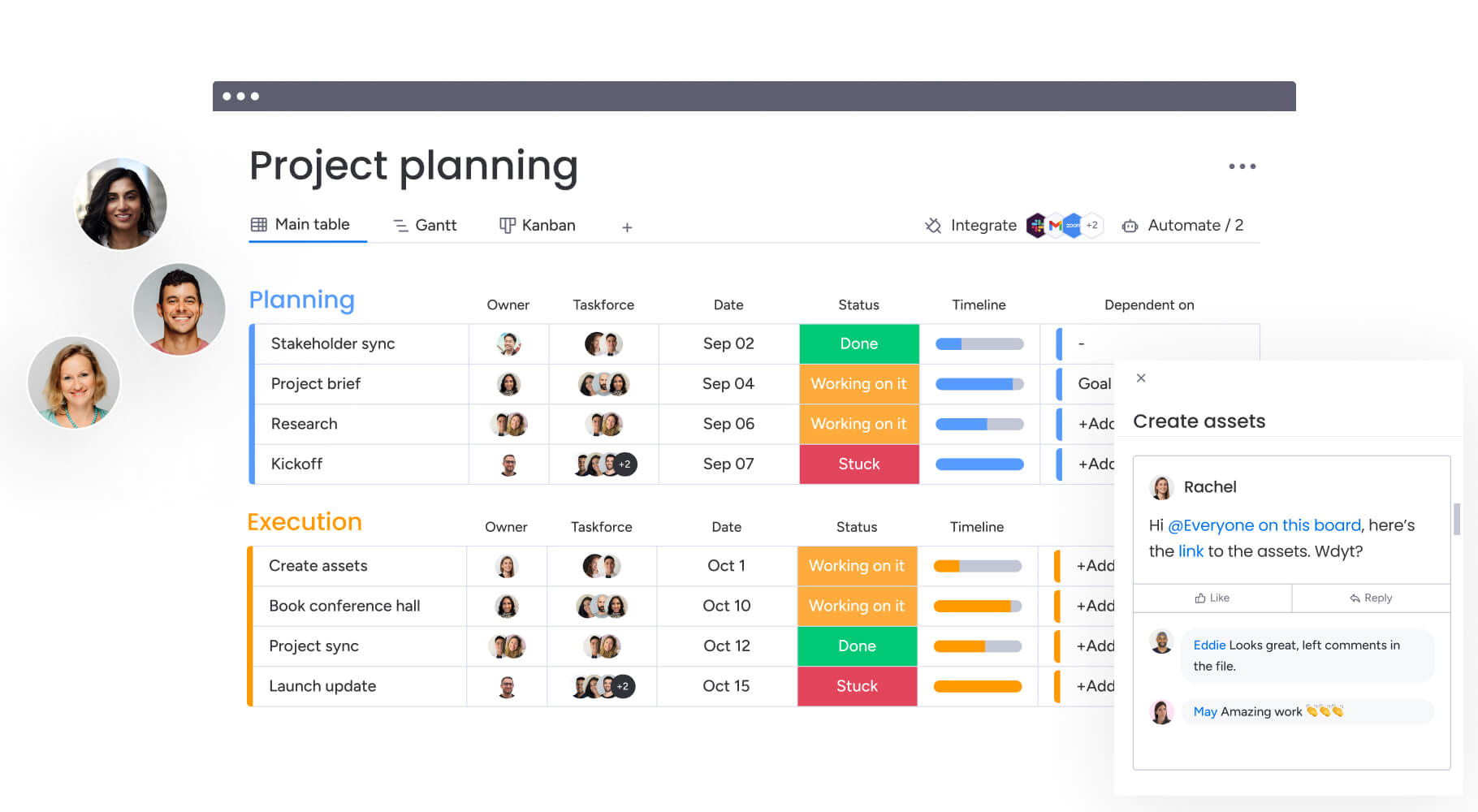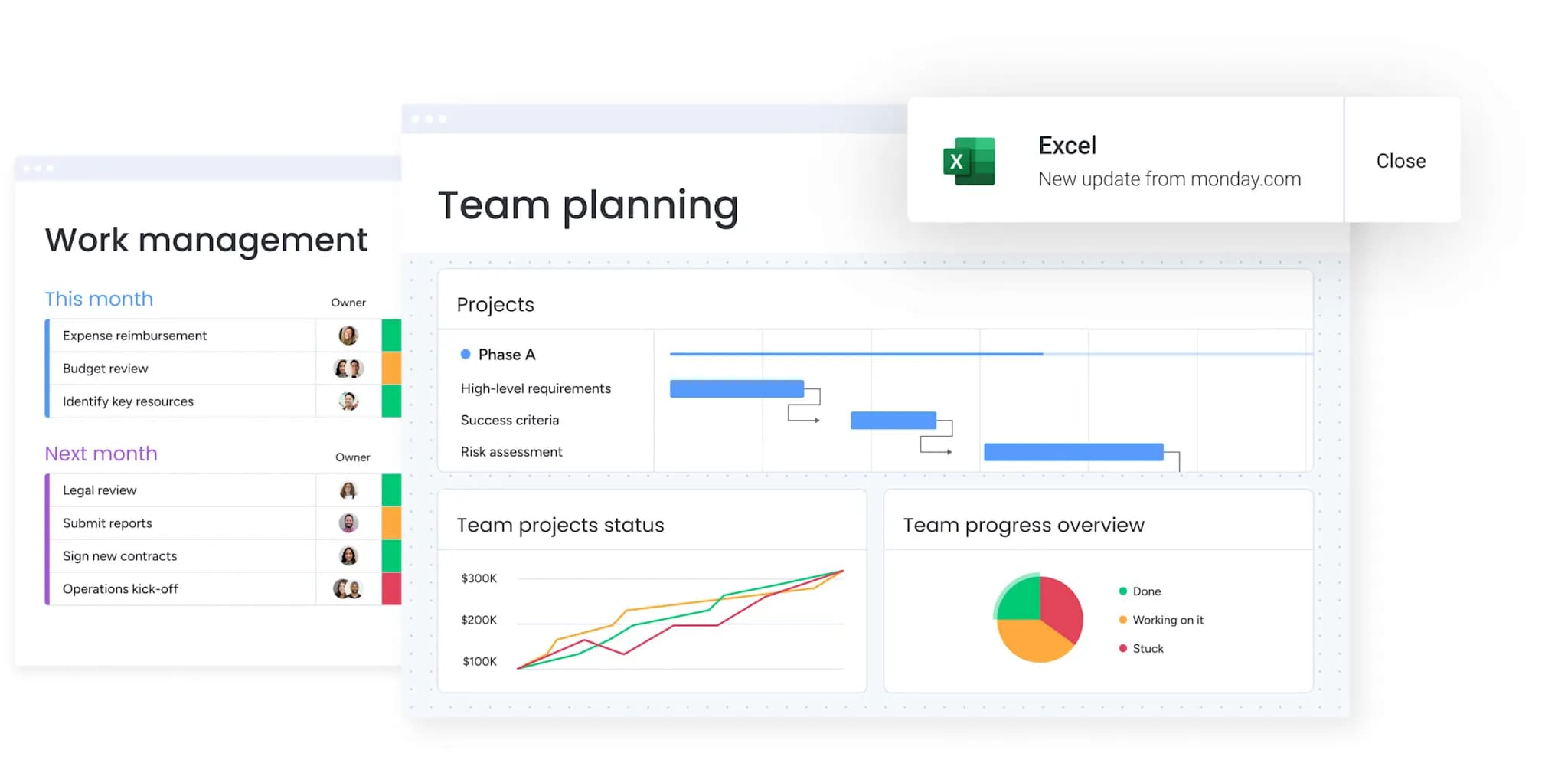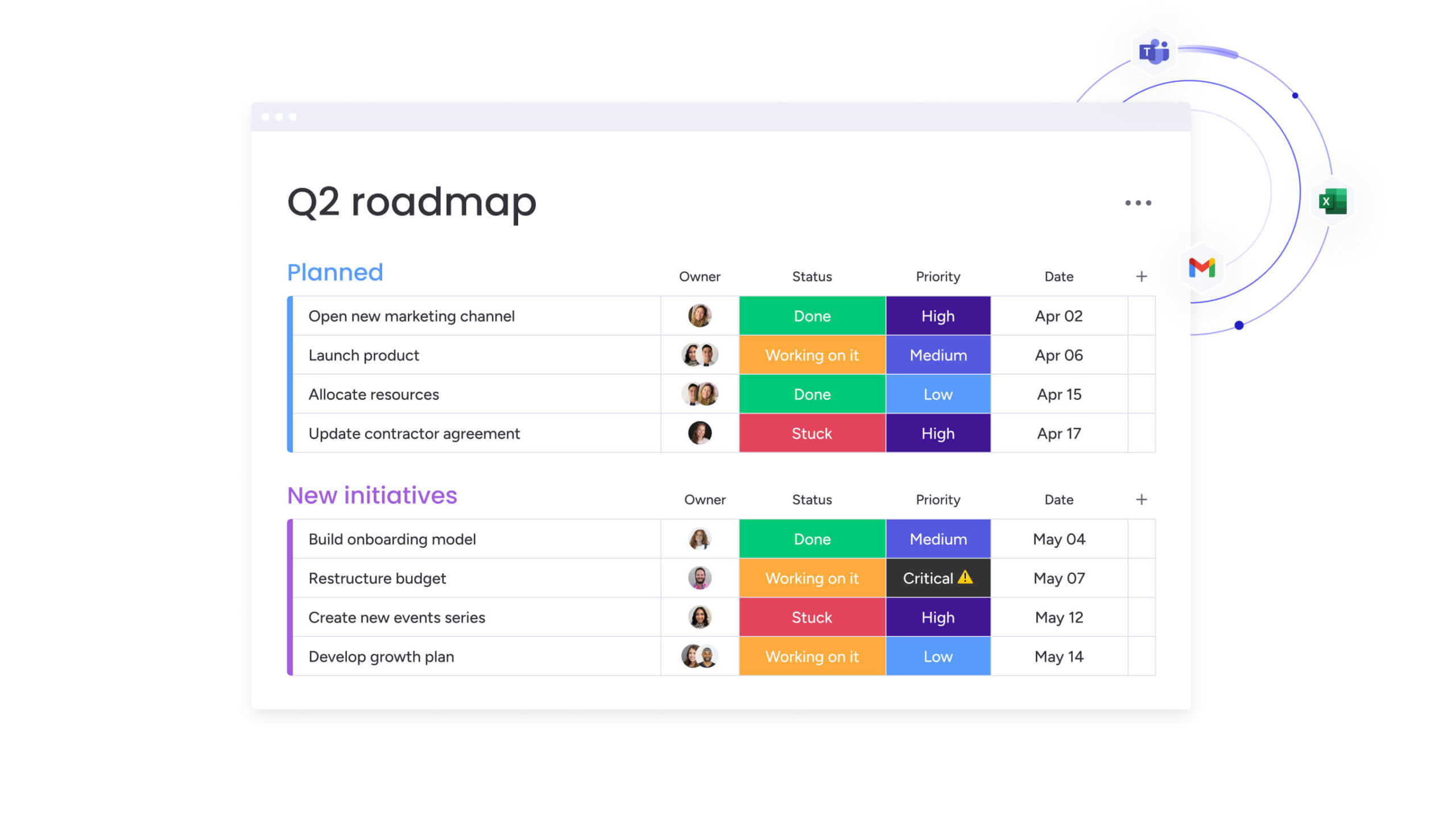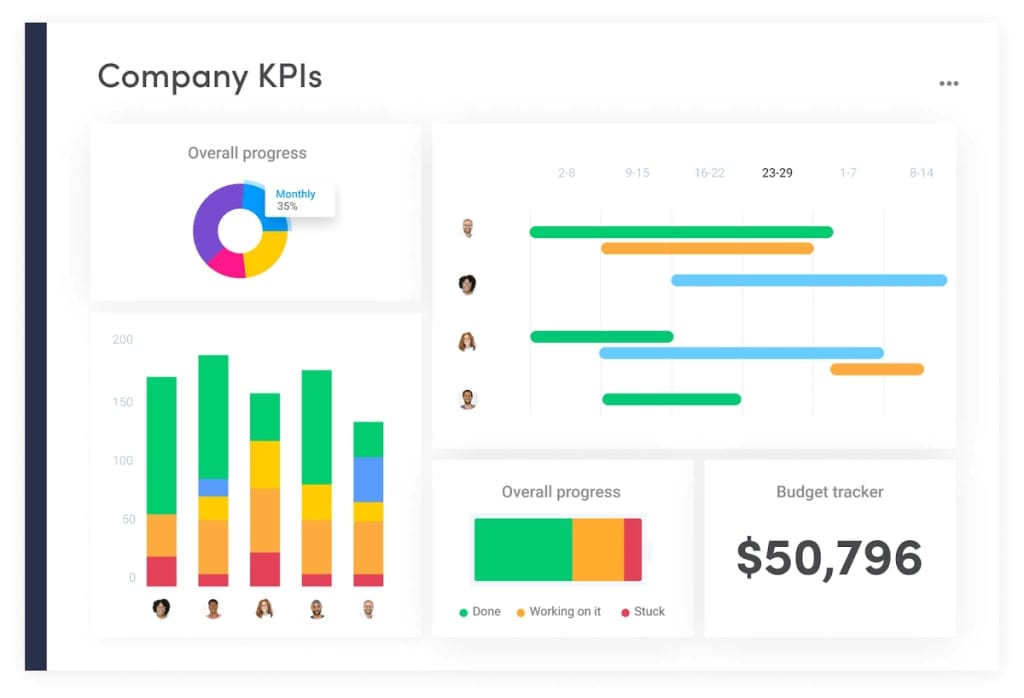Behind every successful business is a well-run operation — one where people, processes, and technology work together to deliver consistent results. When operations run smoothly, teams collaborate better, projects move faster, and customers notice the difference.
Operations management is what makes that possible. It brings structure to complexity, turning big-picture strategy into everyday execution. From optimizing resources and improving workflows to ensuring quality and efficiency, effective operations management helps organizations work smarter and scale with confidence.
In this guide, we explore how modern operations teams drive performance through clear processes, data-driven decision-making, and unified systems that keep everyone aligned toward shared goals.
Key takeaways
- Streamlined operations: effective operations management transforms scattered activities into coordinated processes that deliver consistent value to customers.
- Core functions: planning, process design, quality control, resource allocation, and supply chain coordination work together to improve efficiency across the organization.
- Integrated execution: modern platforms like monday work management connect strategy to action through automated workflows, real-time dashboards, and AI-driven insights that enhance productivity.
- Scalable results: strong operational practices reduce costs, accelerate delivery, increase customer satisfaction, and build systems designed for sustainable growth.
- Continuous improvement: tracking metrics such as productivity, quality, and cycle times enables teams to refine performance and maintain long-term success.
What is operations management?
Operations management is the administration of business practices to create the highest level of efficiency possible within an organization, with successful implementations leading to productivity gains of 30% to 50%. It’s about transforming inputs — materials, labor, and technology — into outputs that deliver value to customers.
Picture this concept as the engine that keeps your business running. Operations managers coordinate everything from supply chain management to quality control, ensuring work flows smoothly across departments.
Defining operations management
On a fundamental level, operations management focuses on designing, overseeing, and controlling production processes. This applies whether you’re manufacturing products or delivering services.
This discipline covers several key areas that work together to drive business success. Understanding these components helps you see how a structured approach to operations can transform your organization’s performance and reliability.
- Process oversight: managing workflows from start to finish.
- Resource coordination: allocating people, materials, and technology effectively.
- Quality assurance: ensuring outputs meet standards and customer expectations.
- Performance optimization: continuously improving processes for maximum efficiency.
Every industry relies on operations management principles. For example, healthcare systems use it to reduce patient wait times whereas retailers apply it to manage inventory. Further, tech companies even leverage it to streamline product development.
What is the role of operations managers?
Operations managers bridge the gap between strategy and execution. They turn high-level business goals into actionable plans that teams can implement daily.
These professionals wear many hats:
- They analyze performance data to spot bottlenecks.
- They coordinate with suppliers to ensure materials arrive on time.
- They work with HR to staff projects appropriately.
Modern operations managers also embrace technology, using platforms like monday work management to track progress across projects, allocate resources based on real-time data, and maintain visibility into complex workflows.
5 core functions of operations management
Every successful organization relies on a set of core operational functions that keep work moving efficiently from strategy to execution. These functions form the backbone of how businesses plan, deliver, and continuously improve — turning day-to-day activity into long-term results.
Below, we break down the five key functions that define effective operations management:
1. Planning and forecasting
Planning starts with understanding what’s coming. Operations managers analyze market trends, historical data, and business objectives to predict future demand.
This function includes capacity planning — a core aspect of operational planning. It also involves demand forecasting to anticipate customer needs and adjust operations accordingly.
With platforms like monday work management, teams can visualize demand patterns through customizable dashboards. Real-time reporting helps managers adjust plans as conditions change.
2. Process design and optimization
Every organization runs on processes — but not all of them run efficiently. Process design focuses on building workflows that minimize waste, maintain quality, and keep work moving seamlessly across teams.
Operations managers refine these processes by:
- Mapping existing workflows: identifying bottlenecks and inefficiencies.
- Standardizing procedures: ensuring consistency and quality at every stage.
- Introducing automation: removing repetitive manual steps to save time and reduce errors.
Modern platforms like monday work management make this optimization easier by allowing teams to design workflow templates that capture best practices, automate routine actions, and track performance in real time — ensuring processes stay efficient as the organization scales.
3. Quality management
Quality isn’t just about the final product. It’s about building reliability into every step of your operations.
This function includes both quality control and quality assurance. Quality control inspects finished outputs. Quality assurance maintains reliable processes throughout production.
Teams using monday work management can track quality metrics in real-time. Automated alerts flag issues before they impact customers. Documentation features support continuous improvement efforts.
4. Resource allocation
You have limited resources. How do you use them most effectively? Resource allocation distributes people, equipment, and budget based on priorities and constraints.
This involves workforce scheduling, equipment planning, and budget management. Managers must balance competing demands while preventing overallocation, often leveraging enterprise resource management to optimize resource distribution.
monday work management’s workload views show exactly who’s available and who’s overloaded. Resource planning features help managers make data-driven staffing decisions, a crucial aspect of PMO resource management.
5. Supply chain coordination
Your supply chain connects everything from raw materials to customer delivery. Operations managers ensure this complex network runs smoothly.
Key activities include vendor management, inventory control with warehouse software, and logistics coordination. Managers must balance cost, quality, and reliability while maintaining flexibility, which includes effective order management protocols.
With integrated workflows in monday work management, teams can track supplier performance and coordinate deliveries. Automated notifications keep everyone aligned on timing and expectations.

4 types of operations management
Operations management looks different across industries, but the goal is always the same — to turn resources into results as efficiently as possible. Each type focuses on distinct priorities, from producing goods to delivering services or aligning long-term strategy with day-to-day execution.
Understanding these four main types helps clarify how operations teams create value, whether through production, service delivery, strategic planning, or tactical execution.
Manufacturing operations
Manufacturing operations transform raw materials into finished products. This type emphasizes production efficiency, inventory management, and quality control.
Key focus areas include production scheduling, equipment maintenance, and supplier coordination. Manufacturing managers work to minimize waste and maximize throughput.
Industries like automotive and electronics rely heavily on these principles. They use operations management and production management software to maintain consistent output while meeting quality standards.
Service operations
Service operations deliver intangible value to customers. Unlike manufacturing, you can’t stockpile services — they’re produced and consumed simultaneously.
This creates unique challenges. Service operations managers must balance staff availability with fluctuating demand. They focus on customer experience metrics and service quality standards.
Healthcare, hospitality, and financial services exemplify service operations. These industries use operations management to reduce wait times and improve customer satisfaction.
Strategic operations management
Operations strategy involves long-term decisions that shape your competitive position. These choices have lasting impacts on organizational capabilities.
Examples include facility locations, technology investments, and partnership decisions. Strategic operations managers think years ahead, not just quarters.
Monday work management supports strategic planning through portfolio management features. Leaders can track major initiatives and ensure operational activities align with strategic goals.
Tactical operations management
Tactical operations translate strategic goals into day-to-day action. This function focuses on short-term execution, ensuring plans are carried out efficiently and adjusted as conditions change.
Core responsibilities include:
- Scheduling and coordination: managing daily tasks, shifts, and workloads.
- Problem-solving: resolving issues that disrupt productivity or timelines.
- Resource adjustments: reallocating people or materials to meet immediate needs.
Because responsiveness is key, real-time visibility becomes essential. monday work management supports tactical teams with live dashboards, automated updates, and workload tracking — enabling managers to make quick, informed decisions that keep operations running smoothly.
How operations management works
Operations management turns strategy into action. It connects planning, execution, and continuous improvement in a cycle that keeps organizations efficient and adaptable. At its best, it ensures every process — from resource allocation to performance tracking — works together toward shared goals.
Understanding how operations management works means looking beyond individual tasks to see the full system at play. It is about aligning departments, optimizing workflows, and embracing technology that supports smarter, faster decisions.
The operations management process
The process follows four connected phases that feed into each other. Planning sets objectives and designs processes. Implementation executes those plans while managing daily operations.
Monitoring tracks performance against metrics to identify deviations. Improvement analyzes results and updates processes for the next cycle.
This cyclical approach ensures your operations evolve with changing business needs. What worked last year might not work today. Continuous cycles keep you adaptable.
Integrating operations across departments
Silos kill operational efficiency. When departments work in isolation, you get duplicated efforts, missed handoffs, and conflicting priorities, a problem often seen in large organizations where only 61% of employees in large enterprises are satisfied with transparency.
Integration means operations managers collaborate with every department. They work with sales to understand demand patterns. They coordinate with finance on budgets. They partner with HR on staffing needs.
Intuitive platforms like monday work management help break down these silos through shared dashboards and automated workflows. Different departments stay connected while maintaining their unique processes.
Digital transformation in operations
Technology fundamentally changes what’s possible in operations management, with research predicting that 50% of large global enterprises will use AI and advanced analytics in their operations. Digital platforms and modern management systems enable automation, real-time monitoring, and predictive analytics.
Consider how AI can forecast equipment failures before they happen. Or how automated quality checks catch defects instantly. These capabilities transform reactive management into proactive optimization.

6 key benefits of operations management
Strong operations management delivers tangible improvements across every part of an organization. When processes run efficiently and teams stay aligned, businesses reduce waste, improve quality, and make better use of their resources.
The benefits below show how effective operations management drives performance: from efficiency and cost savings to scalability, customer satisfaction, and lasting competitive advantage.
1. Increased operational efficiency
Efficiency means doing more with less. Operations management identifies and eliminates waste throughout your processes.
This includes reducing wait times between process steps. It means eliminating redundant approvals. It involves optimizing resource utilization so nothing sits idle.
2. Reduced costs and waste
Every inefficiency costs money. Operations management systematically reduces these costs by optimizing processes and resource use.
Direct cost savings come from reduced material waste and labor efficiency. Indirect savings arise from fewer errors, less rework, and prevented delays.
These improvements compound over time. Small efficiency gains in daily operations translate to significant annual savings.
3. Enhanced customer satisfaction
Customers notice when operations run smoothly. They receive consistent quality. Orders arrive on time. Service interactions resolve quickly.
Operations management ensures you meet commitments reliably. This builds trust and encourages repeat business.
With monday work management, teams maintain visibility into customer-impacting processes. Automated alerts ensure nothing falls through the cracks.
4. Data-driven decision making
Gut feelings don’t scale. Operations management provides the data you need to make informed decisions.
Key metrics reveal trends before they become problems. Analytics show which processes need attention. Real-time reporting enables quick course corrections.
This data-driven approach reduces uncertainty. You know exactly where to focus improvement efforts for maximum impact.
5. Scalability and growth
Growth breaks poorly managed operations. But strong operations management creates foundations that support expansion.
Standardized processes can be replicated in new locations. Documented procedures enable quick onboarding. Scalable systems handle increased volume without proportional complexity increases.
Organizations with mature operations can seize growth opportunities faster. They’re ready to scale when the market demands it.
6. Competitive advantage
Operational excellence creates advantages competitors struggle to match. You deliver faster. Your quality stays consistent. Your costs remain lower.
These advantages compound into market leadership. Customers choose you for reliability. Investors value your efficiency. Talent joins for your operational sophistication.
Superior operations also free resources for innovation. While competitors fight fires, you invest in the future.
Operations management vs project management
While operations management and project management share similar goals — improving performance and driving results — they differ in focus, scope, and execution. Understanding how they complement each other helps organizations balance long-term efficiency with short-term objectives.
The table below outlines the key differences between the two disciplines, highlighting how each contributes to overall business success.
| Aspect | Operations management | Project management |
|---|---|---|
| Focus | Ongoing processes | Temporary initiatives |
| Timeline | Continuous | Defined start and end |
| Scope | Broad organizational functions | Specific deliverables |
| Goals | Efficiency and optimization | Completing objectives on time |
| Resources | Permanent staff | Temporary team assignments |
| Metrics | Operational KPIs | Project completion metrics |
Both areas work best when integrated. Projects often deliver the improvements that strengthen daily operations, while ongoing operations provide the stability and structure that allow projects to succeed.

Essential platforms for modern operations management
Modern operations rely on connected digital systems to keep work efficient, transparent, and adaptable. The right platforms automate routine tasks, surface real-time insights, and give teams the visibility they need to make better decisions faster.
Below are the core technologies that power effective operations today — from workflow automation and performance analytics to resource planning and real-time reporting.
Workflow automation platforms
Workflow automation platforms remove repetitive manual work, allowing teams to focus on high-impact initiatives. They connect departments, data, and processes through intelligent workflows that run efficiently without constant supervision.
Key capabilities include:
- Conditional logic: automatically route work based on task type, priority, or ownership.
- System integrations: connect existing tools without the need for custom development.
- Template libraries: provide ready-made workflows for common operational processes.
Modern platforms like monday work management bring automation to life through an intuitive visual interface. Teams can design and customize workflows, trigger updates automatically, and maintain full visibility across every process — ensuring operations stay fast, consistent, and aligned.
Performance analytics systems
You can’t improve what you can’t measure. Analytics platforms transform operational data into actionable insights.
These systems track KPIs in real-time. They identify trends before they become problems. They provide predictive insights that support proactive management.
Dashboard functionality makes complex data accessible. Visual representations help stakeholders understand performance instantly.
Resource planning platforms
Resource planning platforms help teams make the most of limited capacity by optimizing how people, equipment, and budgets are allocated. They ensure work is balanced across teams and projects, preventing burnout while maximizing productivity.
Core capabilities include:
- Real-time visibility: monitor availability to avoid overbooking or idle time.
- Skill-based allocation: match the right people to the right tasks for better results.
- Capacity forecasting: anticipate future resource needs based on upcoming workloads.
Sophisticated solutions like monday work management provide dynamic workload views and capacity planning tools that help managers balance assignments, spot bottlenecks early, and make confident staffing decisions.
Real-time reporting dashboards
Speed matters in operations. Real-time dashboards provide instant visibility into performance across your organization.
Automated alerts notify managers when metrics deviate from targets. Drill-down capabilities let you investigate issues immediately. Mobile access ensures you stay informed anywhere.
These dashboards transform operations from reactive to proactive. You spot problems while they’re still small and manageable.
How to measure operations management success
You cannot manage what you do not measure. Tracking performance through the right metrics allows operations teams to see what is working, identify gaps, and make informed decisions that drive improvement.
Effective measurement links strategy to execution: turning data into action that strengthens efficiency, quality, and overall business performance.
Key performance indicators (KPIs)
Effective measurement starts with choosing the right KPIs. These metrics must reflect your specific operational goals and business objectives, a crucial step given that employees who understand how success is measured are twice as likely to feel motivated.
Common operational KPIs provide objective performance data:
- Productivity metrics: output per hour, resource utilization rates.
- Quality indicators: defect rates, customer satisfaction scores.
- Financial measures: cost per unit, profit margins.
- Time-based metrics: cycle time, on-time delivery performance.
Within monday work management, comprehensive KPI tracking is made simple. Customizable dashboards keep stakeholders informed about trends and deviations automatically.
Efficiency and productivity metrics
Efficiency measures how well you convert inputs to outputs. Productivity tracks the rate of output generation.
Throughput shows work volume completed per timeframe. Capacity utilization reveals how effectively you use available resources. Labor productivity measures output per employee hour.
These metrics highlight improvement opportunities. They show where bottlenecks constrain performance and where resources sit idle.
Continuous improvement methods
Measurement only matters if it drives action. Continuous improvement methodologies provide structured approaches for enhancing performance.
Methods like Kaizen emphasize incremental changes that compound over time. Lean principles focus on eliminating waste. Six Sigma uses data to reduce variation.
Monday work management supports these methodologies through project tracking and collaborative workflows. Teams can implement improvements systematically and monitor their impact.

Transform your operations with monday work management
Modern operations demand modern solutions, with monday work management bringing together everything you need to optimize operations in one unified platform.
- The platform connects strategic goals with daily execution. Customizable workflows adapt to your specific needs while maintaining consistency across teams.
- Cross-departmental workflows eliminate silos between functions. Real-time dashboards surface performance metrics and emerging issues instantly.
- Resource optimization features prevent overallocation while maximizing efficiency.
- Process automation handles routine tasks consistently. This frees your team to focus on improvements and strategic initiatives rather than manual coordination.
Built-in intelligence for smarter operations
AI capabilities in monday work management take operations to the next level. These features reduce manual effort while improving decision quality.
Powerful automations
Eliminate manual work and accelerate operations with customizable automations that handle routine tasks. Set up triggers and actions that keep work flowing without constant oversight.
- Create conditional automations that route approvals based on specific criteria.
- Schedule recurring tasks and notifications to maintain operational rhythm.
- Build multi-step automation recipes that handle complex workflows end-to-end.
200+ integrations
Connect your entire tech stack through monday work management’s extensive integration network. Unify data across platforms to create a single source of truth for operational visibility.
- Sync with CRM systems to align operations with customer demands.
- Connect financial tools to link operational activities with budgets.
- Integrate communication platforms to maintain team alignment.
Advanced AI tools
Leverage AI-powered capabilities that transform how you manage operations. These intelligent tools analyze patterns, suggest improvements, and automate complex decisions.
- Use AI Blocks to categorize data and extract insights from documents.
- Deploy Digital Workers that monitor operations and detect timeline slips.
- Implement the Project Analyzer to receive resource reallocation suggestions.
Frequently asked questions
What are the 7 main functions of operations management?
The seven main functions of operations management are planning and forecasting, process design, quality management, resource allocation, supply chain coordination, performance monitoring, and continuous improvement. These functions work together to optimize business operations and achieve organizational goals efficiently.
What is an example of operations management in retail?
An example of operations management in retail is a store managing its inventory levels, coordinating staff schedules, organizing product deliveries, and ensuring checkout efficiency. The store must balance customer demand with available resources while maintaining service quality and controlling costs.
Is operations management a good career path?
Operations management offers excellent career opportunities with strong growth potential and competitive salaries. Professionals develop valuable skills in analytics, leadership, and strategic thinking that apply across industries, making it a versatile and rewarding career choice.
What skills do operations managers need most?
Operations managers need analytical thinking to interpret data, communication skills to coordinate across departments, problem-solving abilities to address challenges, and technical proficiency with management platforms. Leadership skills and business acumen are also essential for driving operational excellence.
How do small businesses implement operations management?
Small businesses can start operations management by documenting core processes, establishing basic performance metrics, and using digital platforms to coordinate work. Begin with critical processes like order fulfilment or customer service, then expand operational oversight as the business grows.
What's the difference between operations management and supply chain management?
Operations management encompasses all internal business processes including production, quality, and resource management, while supply chain management specifically focuses on external relationships with suppliers and distributors. Supply chain management is one component within the broader scope of operations management.
